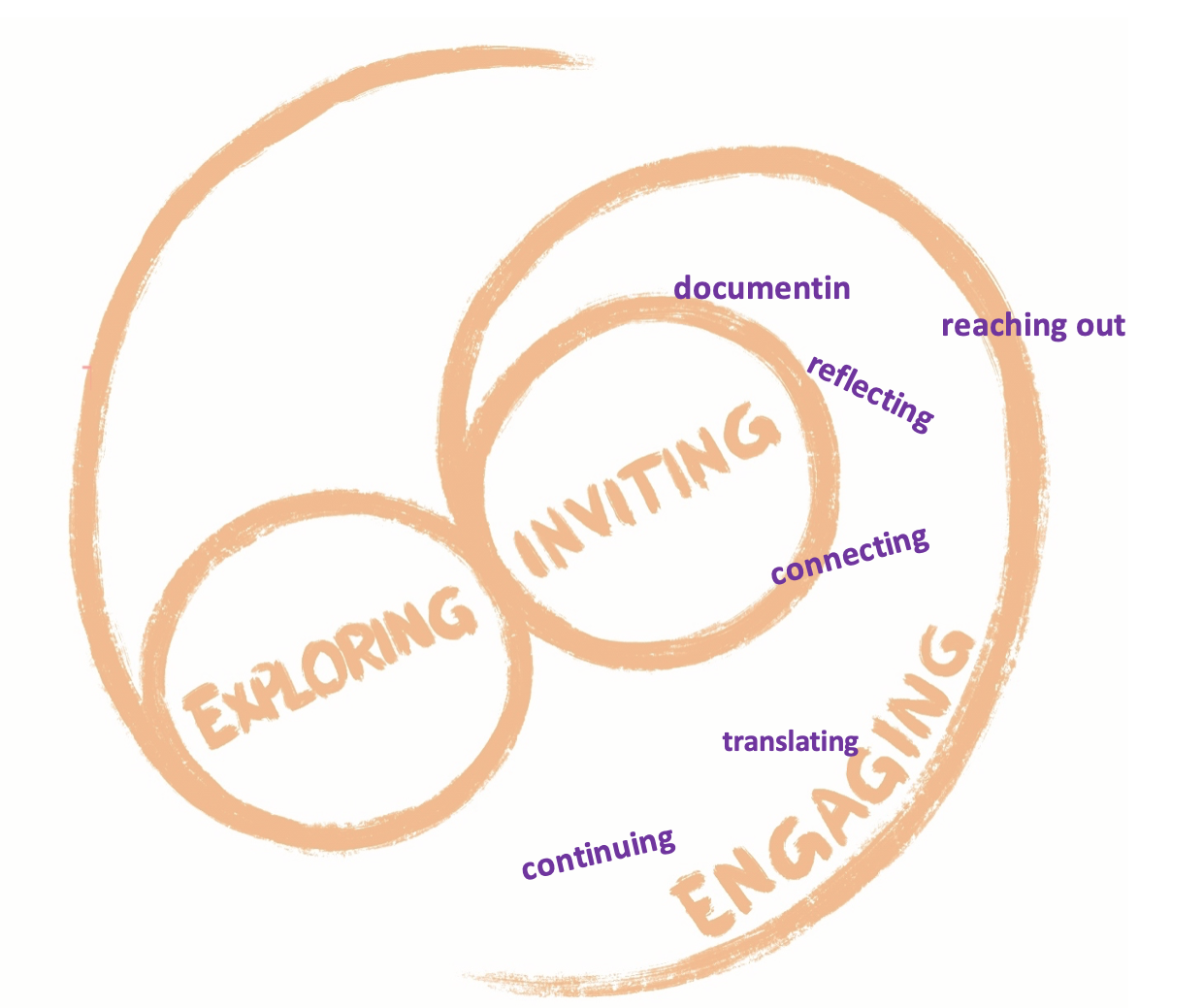Engaging
Description
The third learning movement consists of 3 components: presentation of- and reflection on the design and enactment of the imaginative dialogues, translation and transfer of the insights to the urgencies in one’s own (arts educational) practice, further development of PIMDI-based arts education and community building.
The learning movement starts with presenting, documenting, and reflecting on the experiences derived from the imaginative dialogues that have been performed. By embracing embodied and multi-sensory forms of reflection, students can enhance their comprehension and engagement with the encountered experiences. This approach fosters a more holistic and immersive exploration, enabling students to tap into their sensory perceptions and to engage with material and questions on a deeper level.
It also promotes the building of a community that collectively learns and grows through shared reflection and knowledge exchange. Through this reflective and community-building process, students can uncover new insights and contribute to the broader development of the PIMDI approach. It offers a pathway for continuous growth, ensuring that imaginative dialogues remain a dynamic and evolving field of exploration.
‘Engaging’ also entails reaching out to the world and grappling with larger societal issues, even those that are polarizing. Based on the belief that an open and imaginative dialogue space can give voice to all perspectives without predetermined goals or outcomes, there is increased courage to engage in dialogue authentically – even without words.
This engagement involves actively addressing and exploring complex societal challenges, leveraging the power of imaginative dialogues to foster understanding, and collective action. It embraces the notion that through dialogue, diverse voices can be heard and valued. It requires a willingness to engage with discomfort, to navigate tensions, and to seek common ground while respecting differing viewpoints.
Components and movements

It is a movement forward and backward, a movement that can fan out and return.
A movement of transfer: from what is experienced and learned to one’s own practice.
And above all, it is a movement that enables the future, one that reaches out and connects.
Examples
Presentation and reflection:
Part of the 2nd learning movement is the invitation to reflect permanently in an imaginative and embodied way on the learning process, individually and in the subgroup. Create a permanent spot to collect these reflections for the last learning movement. Install, for example, a reflective documentation wall. Offer a metaphor to visualise the PIMDI learning, for example, a diamond. Students can develop and draw their own diamonds and put them on the wall. During ‘Engaging’, the students present the imaginative dialogue they have designed and enacted to each other together with the reflections in the diamond. Collect keywords from the presentations. Put the words on the floor or on the wall and start weaving a web together while looking for similarities and differences.
Other possibilities to present and share reflections, individually and collectively:
- Performance lecture: students move by telling/reflecting on their learning
- Positioning in space: students are asked to move between certain indicated dimensions or values and choose a position.
- Collective drawing (with music in the background).
Look for more examples of reflective documentation in an imaginative and embodied way in these exercises: LINK
Translation and transfer
Ask students to create variations on the developed dialogue and dialogue regarding their own specific practice, for example, as a theatre educator for young people. Provide a digital platform to share future experiences.
Learning
The learning of students and teachers derives from the reflective documentations they share with each other. Acquired insights are translated to one’s own arts educational practice. Sensitised by the practices of PIMDI, students and teachers continue to deepen their work as socially engaged artist educators.
In addition to the awareness and abilities mentioned under ‘exploring’ and ‘inviting’:
Awareness:
- of the connection and tension between the personal and societal; between smaller and bigger differences, and also between praxis and theory.
- of the performativity of dialogical spaces.
Ability:
– to navigate between the perspectives of an interlocutor, facilitator, artist, educator, and guide
– to transfer one’s own experiences by reflecting and theorizing as meaningful for other contexts.
Arts pedagogical sensitivity:
– to be able to hold the space’
– to give time and space to reflective documentation
– to create cornerstones for community building.
